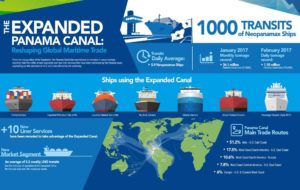The Panama Canal Authority celebrates another milestone less than nine months after the expansion: With »MSC Anzu«, the 1000th vessel of the Neopanamax type has transited the waterway.
The containership was heading northbound from the Atlantic to the Pacific Ocean, measuring 299.[ds_preview]98m in length and 48.23m in beam with a carrying capacity of 9,008 TEUs. During its transit, the ship called at Panamanian port terminals on the Pacific and Atlantic to discharge and load cargo on the way to its final destinations.
»Today’s transit represents a considerable milestone, marking the industry’s strong adoption of the Expanded Canal and its successful operations thus far,« said Panama Canal Administrator Jorge L. Quijano.

According to the statement, the canal is experiencing a steady flow of traffic – including containerships, liquid petroleum gas vessels, and liquefied natural gas (LNG) vessels. Other segments like dry bulk carriers, vehicle carriers, and crude product tankers have also transited through the Expanded Canal.
The container segment accounts for nearly half the transits through the Expanded Canal and represents its principal source of traffic. 53% of containership cargo transiting the waterway does so using the Expanded Canal. As of March 2017, the average number of Neopanamax vessels transiting the new lane per day is 5.9.
Increasing volumes
Traffic at the waterway continues to increase with each passing month. In February 2017, the Panama Canal set a new daily tonnage record of 1.18 million Panama Canal tons (PC/UMS) after welcoming a total of 1,180 vessels through both the Expanded and original locks. The previous records were established in December 2016 and January 2017, when the waterway set monthly tonnage records for transiting 35.4 million PC/UMS and 36.1 million PC/UMS, respectively.
The ACP added, that many major liner services have already redirected service to the waterway. Thus far, 13 Neopanamax liner services have been deployed through the new locks, primarily on the U.S. East Coast to Asia trade route. And on April 1, two additional Neopanamax liner services are expected to follow, bringing the total liner services to 15.
A couple of days ago, the ACP announced plans to launch a state-of-the-art vessel scheduling and maritime resource management system to optimize operations, uphold exemplary safety standards, and increase the efficiency and reliability of services as it handles this uptick in traffic.
















